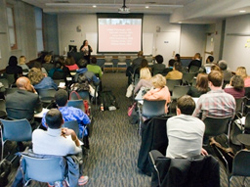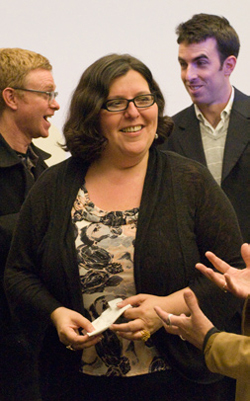Lonely at the Top
Being president of a black college was an often thankless task
Being president of a black college was an often thankless task
By Emily Rosenbaum
“Negroes don’t control this school or much of anything else…nor white folk either,” says Dr. Bledsoe, fictional president of a black college, in Ralph Ellison’s Invisible Man. “True they support it, but I control it. I’s big and black and I say ‘Yes, suh’ as loudly as any burrhead when it’s convenient, but I’m still the king down here.”
“In scholarship, fiction, and media accounts, Black college presidents are often characterized in negative ways: accommodationist, authoritarian and Uncle Tom,” said Visiting Professor Marybeth Gasman, Associate Professor of Higher Education at the University of Pennsylvania, in her November 2 talk at TC, “Perceptions of Black College Presidents: Black College Presidents’ Perceptions of Self.”
Those portrayals are highly oversimplified, argued Gasman, whose talk focused on two real-life presidents of Historically Black Colleges, Frederick D. Patterson of Tuskegee Institute and Willa Player of Bennett College. “The situation is a lot more nuanced than is being presented.”
Patterson, who led Tuskegee from 1935–1953, “was regarded as a conservative by many and chose to work within the system,” Gasman said. Yet his ideas were similar to those of Langston Hughes, W.E.B. Du Bois and A. Philip Randolph, all of whom were considered radicals. Patterson’s goal was to introduce students to the work of prominent African-American thinkers, and he also secured the participation of Tuskegee in the Civilian Pilot Training Program, which produced the first black U.S. military pilots. And while he may have presented a diplomatic face to the white world, a colleague from the United Negro College Fund reported that Patterson “walked around mad as hell all the time” because he was so frustrated with the demands of white leaders who he had had to appease. “But,” Gasman said, “he was able to play multiple roles because sometimes that’s what you need to do.”
As a woman, Player, who led Bennett from 1956–1966, had to negotiate issues of gender as well as race, Gasman said. Historians often overlook black female college presidents, she said, and their students as well. For example, the young women of Bennett College were instrumental in fundraising and organizing for the lunch counter sit-ins conducted by male students at North Carolina Agriculture and Technical State University, but they get very little mention in the history books, Gasman said, because “they weren’t sitting in the seats.”
When Player is discussed in histories, she generally is referred to as soft-spoken and pleasant—qualities that led many of Greensboro’s whites at the time to view her as an ally in their effort to control the local civil rights activities. However, Player supported the sit-ins and was the only black leader to allow Martin Luther King, Jr., whose talks often produced white backlash, to speak in Greensboro.
Patterson and Player were not Bledsoes. They were complicated people trying to make progress in the face of great opposition, and like many of their colleagues, they walked the line as best they could. “I don’t know what I would be doing if I were a Black man in the 1940s leading a Black college in Tennessee,” Gasman said. Black college presidents were imperfect. Player, for example, dismissed a teacher accused of Communism. But Gasman’s work suggests not only that depictions of black presidents were unfair, but also that neither revolutionaries nor those who work inside the system are the exclusive agents of social change.
Published Monday, Dec. 20, 2010

